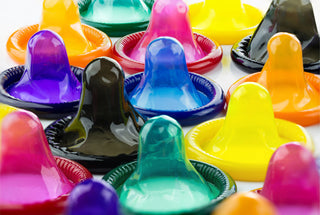STDs (sexually transmitted diseases) or STIs (sexually transmitted infections) are an unfortunate part of an active sex life. Ideally, people should be tested for STDs regularly and open about their sexual status with partners.
However, some STDs may not be detected during screening. As such, people should rely on condoms to reduce the risk of transmission and enjoy a healthy sex life. Both male condoms and female condoms are effective in helping HIV prevention and reducing the chance of getting other diseases that are spread by sexual transmission and mixing bodily fluids.
Within this article, we are looking at condoms’ effectiveness against STD transmission during sexual contact, which STDs are not prevented by condoms, and some other useful topics.
Read on for more information.
Table of Contents:
- How Effective are Condoms Against STDs?
- What STDs Do Condoms Not Prevent?
- Will Condoms Stop Chlamydia and Gonnorhea?
- Will Condoms Prevent HIV?
- What Can You Do to Improve Condom Efficiency Against STDs?
- How Else Can You Reduce the Risk of STD Transmission?
- What are Flavoured Condoms for?
- Do Any Condoms not Prevent STDs?
- Can I Have Sex with Somebody with an STD?
How Effective are Condoms Against STDs?
Consistent use of medically certified latex condoms can reduce your risk of catching sexually transmitted diseases, though no condom provides 100% protection. Condoms are typically 98% effective at preventing pregnancy and STD transmission. All medically certified condoms need to be used every time you have sex to ensure maximum protection.1
If you use your condom inconsistently, you may catch an STI because STI transmission can happen after one time with an infected partner. We are often asked - can you get an STD from a condom? and there are many things you can do to reduce the chance of getting an STD.
In addition, if you do not use your condom correctly, protective properties may be reduced even when you start using them consistently again.
The most effective way to reduce the transmission of STDs is to refrain from sexual activity or remain in a long-term monogamous relationship with an uninfected person. Unfortunately, some people may be unaware they are infected because some STDs do not show symptoms.2
How Do Condoms Stop STDs?
Studies have shown that latex condoms provide a practically impervious shield to STD pathogens.
However, the condom’s effectiveness at protecting against different diseases depends on how those diseases are passed on in the first place. Condoms block infections by stopping contact between the wearer’s penis and their partner’s genital secretions, skin, and mucosa.
Condoms offer the most protection against diseases transmitted through genital secretions. Condoms also provide some degree of protection for ulcer diseases and HPV as they will cover infected areas (skin or mucosa); however, people can still come into contact with uncovered areas of skin and catch the STD.2
My Partner Has HIV? Can We Enjoy an Active Sex Life with Condoms?
Many studies have shown that correct and consistent use of condoms is a highly effective way of preventing HIV infection if one partner has the virus and the other does not.2
How are STDs Transmitted?
STDs are transmitted in two ways.
Certain diseases, such as gonorrhoea, chlamydia, and HIV, are passed on through infected vaginal and urethral secretions coming into contact with mucosal surfaces (cervix, vagina, or urethra.
However, other diseases (such as genital ulcer diseases like syphilis, chancroid, genital herpes, plus HPV infection) are transmitted when infected skin or mucosal surfaces come into contact.2
What STDs Do Condoms not Prevent?

While condoms effectively prevent the transfer of certain STDs, they are not as effective for other STDs, namely syphilis, genital herpes, and HPV (genital warts).2
What is Syphilis?
Syphilis is a bacterial infection passed on via oral, anal, or vaginal sex. One of the initial symptoms of syphilis is a sore (known as a chancre), which develops around the infected site and can be transferred via skin-to-skin contact.
Other symptoms include:
- Additional ulcers and sores around the genitals, anus, or mouth.
- Red rash covering the soles of the feet or palms of the hands.
- Skin growths (they look similar to genital warts) spring up around the vulva or anus (for men and women).
- White patches in and around the mouth
- Tiredness
- Joint pains
- Headaches
- Fever
- Swollen gland in the armpits, neck, and grain
Some people may develop no symptoms.
If you do not treat syphilis, the infection may spread to other parts of your body and brain, causing severe long-term issues.
Syphilis is treated by antibiotic tablets or antibiotic injections.3
What is Herpes?
The Herpes Simplex Virus (HSV) can be passed on via vaginal, oral, or anal contact with a partner. The virus causes sores around the mouth, genitals, or anus. The virus can be defined as two separate variants.
- HSV-1 (oral herpes) causes fever, blisters and cold sores around the lips.
- HSV-2 (genital herpes) causes sortes around the anus and genitals.
You are most infectious during an active outbreak; you should refrain from sex to lower the chance of transmitting the virus to your sexual partner.
Treatments include:
- Antiviral medication to stop symptoms from worsening - they need to be taken within five days of the symptoms showing
- Topical cream for the pain
There is no cure for herpes. However, repeat outbreaks should lessen in severity and may not require any treatment in the future.4
What are Genital Warts?
Genital warts are growths caused by Human Papillomavirus (HPV), a family of more than 140 viruses. Genital warts are caused by a low-risk form of the virus. Higher-risk versions can cause various types of cancer. HPV is transferred via skin-to-skin contact, usually in areas of your genitals not covered by condoms.
Symptoms of HPV include:
- Painless lumps and growths around your penis, vagina, or anus
- Itching and bleeding from your penis, vagina, or anus
- Changes in your regular flow of pee (your pee may flow in a different direction) that do not rectify themselves
- Your partner develops genital warts, even if you don’t have symptoms yourself
Treatments vary depending on the location and appearance of warts. These include:
- Creams and liquids: Apply medicinal cream or liquids to the affected area a few times a week for several weeks. In some scenarios, you may need a sexual health doctor or nurse to apply the cream. These treatments cause irritation, burning, and pain.
- Surgery: Doctors or nurses may need to burn, laser, or cut warts away. This may cause irritation, pain, or scarring.
- Freezing: Doctors or nurses can also freeze warts until the infected area is healed. Sometimes, freezing treatment is repeated numerous times, causing pain and irritation.
Genital wart treatment may take weeks or months to work; even then, warts may return. For some people, treatment is ineffective.5
How Well Do Condoms Prevent Herpes, Other Genital Ulcer Diseases, and HPV?
Herpes, genital ulcer diseases, and HPV can occur in both female and male genital areas covered by condoms and areas not covered by condoms. Luckily, consistent use of certified latex condoms can reduce your chance of contracting genital herpes, syphilis and other ulcer diseases if the infected area is fully covered and protected. Condom use can also reduce the risk of any HPV or HPV-associated diseases (such as cervical cancer).
Some studies have shown that latex condoms provide a practically impenetrable barrier to particles the same size as STD pathogens.
Theoretically, the condom’s effectiveness depends on the sore, ulcer, or infection location. Condoms will only protect against transmission if it is completely covered. However, there is a chance that the condom will slip down the penis or tear during sex, rendering it less effective than previously. Therefore, you cannot rely on a condom to prevent ulcers and warts as effectively as it would prevent other types of STDs.
STD Studies Show Effectiveness
Some epidemiologic studies compare infection rates among people who do and do not use condoms, offering evidence that condoms provide some protection again syphilis and HSV. However, there is little information regarding condom effectiveness regarding chancroids, another genital ulcer disease. However, some studies have documented reduced transmission risk thanks to consistent condom use when chancroids are the cause of ulcers.
Condoms may also reduce your chance of catching genital warts or developing cervical cancer and mitigate some other consequences of HPV infections. For example, correct condom use has been associated with cervical intraepithelial neoplasia (CIN) regression and even the clearance of HPV in women and associated penile lesions in men.
However, while condom use could be associated with a lower risk of cancer, condoms should not be the only preventative measure you take with your partner. Women should go for regular Pap smears to detect or prevent cervical cancer. In addition, people should also get the HPV vaccination if eligible, as well as use condoms.2
Will Condoms Stop Chlamydia and Gonnorhea?
When used correctly, latex condoms can reduce the chance of passing on sexually transmitted diseases like chlamydia and gonorrhoea. These diseases are transmitted via genital secretions, such as vaginal and urethral secretions.2
What is Chlamydia?
Chlamydia is a common sexual infection that affects both men and women.
Unfortunately, some people never experience any symptoms. However, symptoms can include:
- Pain during urination
- Unusual discharge for your penis, vagina, and anus
- Pain in the stomach, bleeding after sex and between periods (for women)
- Pain, tenderness, and swelling in the testicles (for men)
Chlamydia is treated with antibiotics, which you can get from your GP or a sexual health clinic.
In addition, pregnant women can also give chlamydia to their babies.6
What is Gonorrhoea?
Gonorrhoea is another common sexually transmitted disease.
Like chlamydia, not everybody experiences symptoms when they have gonorrhoea. However, symptoms may include:
- A green or yellow discharge for the penis or vagina
- Pain during urination
- Bleeding between periods (for women)
Gonorrhoea is treated with a course of antibiotics from your GP or sexual health clinic.7
How Do Condoms Stop Chlamydia and Gonorrhoea?
Some laboratory studies have shown that condoms prevent STD-sized pathogens from getting through their latex skin. When somebody infected with gonorrhoea or chlamydia wears a condom, the physical properties of the condom provide an effective barrier against STD transmission.2
Will Condoms Prevent HIV?

When used consistently, latex condoms are very effective in preventing the transmission of HIV.
What are HIV and AIDS?
HIV infection is one of the most deadly sexually transmitted diseases, as it progresses to AIDS and causes serious complications to the immune system.
HIV is a virus that damages the cells in your immune system, affecting the way your body fights diseases and infections. AIDs is the name for numerous life-threatening illnesses and infections once HIV has damaged your immune system.
AIDS cannot be transmitted from person to person, but HIV can.
Currently, there is no cure for HIV infection. However, some effective drug treatments help people live long and happy lives.
HIV symptoms include:
- A short flu-like illness for a week or two. This illness usually occurs two to six weeks after HIV infection.
Once these symptoms disappear, you may not experience other symptoms for years while the virus continues to damage your immune system. This means many individuals do not know they have the virus. If you experience those flu-like symptoms after having unprotected sex, you should get tested just to be safe. Some people, such as gay people, should get regular tests as they are at a higher risk of contracting the virus.8
How Effective are Condoms Against HIV Transmission?
HIV is one of the most researched STDs, particularly following HIV-related epidemics on the African continent and in Western countries during the 80s. As a result, there have been more studies regarding condom effectiveness for preventing HIV infection than other diseases and infections.
If you are wondering how safe is a condom? You will probably be pleased to hear that studies are conclusive that condoms are very effective.
There have been numerous real-life studies of sexually active partners who use condoms consistently. These studies have shown that consistent use of condoms provides effective protection when one person is infected and the other is not.
In addition, laboratory studies have shown that condoms provide an essentially impenetrable shield against HIV-sized particles.
Simply wear the condom correctly, covering the penis, ensuring there is a barrier stopping any exposure to urethral or vaginal secretions, and halting the pathway of sexual HIV infection.2
As well as using condoms, men can also take a medicine called PrEP.
PrEP (or pre-exposure prophylaxis) is a treatment that prevents the spread of HIV in people who have not been exposed to the disease. When used as prescribed, PrEP is very effective at preventing HIV transmission. However, even if you or your partner takes PrEP, you should still use condoms to stop transmitting other sexually transmitted diseases.9
What Can You Do to Improve Condom Efficiency Against STDs?
You can do numerous things to ensure your condom is most effective against STDs. Remember, condoms are highly effective but how you use them can make them less effective.
Only Use Condoms That Fit
Don’t lie to yourself when buying condoms; you need to find the right-sized condom to minimise your chances of catching an STD. If the condom is too big, it can slip off. If the condom is too small or tight, it can tear or break during sex.
If your budget allows, purchase condoms in a few sizes to determine which one is right for you.
Store Your Condoms Correctly
Condoms should be stored in a dry and cool place, such as a bedside drawer or cardboard box. Do not store your condom in a wallet or anywhere that causes too much heat or friction, as this may compromise the condom and render it useless.
Ensure the Condom is in Date
Check the condom has not exceeded the expiration date. If the condom is out of date, it begins to break down and becomes less effective, increasing the risk of STD transmission.
Use Your Hands to Open the Condom
Never try to open a condom with your teeth, scissors, a knife, etc. You may tear or break the condom. Instead, only use your fingers to remove the packaging. You should avoid using oil based lubricants or petroleum jelly with latex condoms as this can weaken them.
Put the Condom on Before Sex Starts
The condom needs to be put on before your penis comes into contact with the vagina or anus. Sexually transmitted diseases can be passed on during grinding, scissoring, outercourse, and intercourse.
Make Sure the Condom is the Right Way Round
Condoms are not reversible; you need to make sure you put them on correctly first time. If you start to roll the condom down your penis and realise it is inside out, don’t flip it over; throw it away and get a new one.
Make sure there is a reservoir at the top of the condom. This is sometimes referred to as the condom’s nipple. The reservoir is where the ejaculate goes when your orgasm. If you don’t leave a space, the ejaculation may cause the condom to tear.
If you are intending to engage in anal sex, you should make sure that you choose the best types of condoms for protection and lubrication during anal intercourse. If you want to find out more about comfortable and safe anal sex, read our blog.
Remove Your Condom and Throw it Away Safely
Once you have finished, take your penis out of your partner, holding the condom to prevent any spillage. Only take the condom off once you are away from your partner.
Next, run water into the condom to ensure it hasn’t broken during intercourse; if water does not leak out, the condom has done its job. Then, tie the condom to stop fluid from spilling out, wrap it in tissue, and put it in the bin. Remember: condoms are not flushable. However, you can buy biodegradable condoms that reduce the environmental impact.
How Else Can You Reduce the Risk of STD Transmission?
If you want to further reduce your risk of STD transmission, follow these tips.
Firstly, people should get regular tests for all STDS, especially if they intend to sleep with new people. This involves getting tested for oral and anal STDs if you plan to have anal or oral sex. Typically, all sexually active people should get tested annually.
However, people should also understand that testing does have limitations. For example, the Centre for Disease Control and Prevention (CDC) recommends only testing for herpes if there are lesions on your body. In addition, there is no way to test for HPV in people born as men. As such, you will need to take additional precautions.10, 11
For instance, you may want to ask your partner if they were explicitly tested for HSV or if they’ve ever kissed or had oral sex with somebody with a cold sore (one type of herpes). People should not be afraid to ask potential partners if their previous sexual partners had confirmed HPV or cervical cancer cases.
You should also ask people about their STD status while you share your results. This stops you from coming across like you are making accusations and makes the decision to disclose your STD status a shared one.
You may want to ask in the following ways:
- Before we have sex, you should know I was last tested (give date), and I’ve had (disclose number) partners since. When were you last tested?
- Would you like to be tested together before having sex?
What are Flavoured Condoms For?

Flavoured condoms are designed to be used for oral sex. The flavoured coating disguises the taste of latex and makes oral sex enjoyable for the person performing the act. More importantly, condoms are the only way to protect yourself from sexually transmitted diseases during oral sex.
Browse our full selection of flavoured condoms here.
Can I Get Non-latex Condoms?
Yes, there is a large range of condoms available for people who are allergic to latex. See our latex allergy collection here.
Do Any Condoms not Prevent STDs?
While most certified latex condoms are 98% effective against pregnancy and STD transmission, certain condoms do not reduce your risk of catching STDs.
Lambskin condoms contain small enough holes to stop semen from getting through. However, those holes are too big to prevent STD particles from getting through.12
Can I Have Sex with Somebody with an STD?
Yes, you can have sex with anybody with a sexually transmitted disease. As long as you know your STD status and make responsible decisions about safe sex practices, you can enjoy a healthy and fulfilling intimate relationship with anybody.
If you would like to browse our entire selection of condoms, simply follow this link. We have a huge range of latex condoms available, including flavoured and vegan condoms.
Does Lube Expire? How to Tell When It's Too Old
Yes, lube does expire so it is important to check the expiry date and also look for any signs that the lube has expired. It can change in colour or smell and sometimes the consistency changes, in which case you shouldn't use it.
References
- https://www.nhs.uk/conditions/contraception/male-condoms/
- https://www.cdc.gov/condomeffectiveness/docs/condoms_and_stds.pdf
- https://www.nhs.uk/conditions/syphilis/
- https://www.nhs.uk/conditions/genital-herpes/
- https://www.nhs.uk/conditions/genital-warts/
- https://www.nhs.uk/conditions/chlamydia/
- https://www.nhs.uk/conditions/gonorrhoea/
- https://www.nhs.uk/conditions/hiv-and-aids/
- https://www.cdc.gov/hiv/basics/prep.html
- https://www.cdc.gov/std/herpes/screening.htm
- https://www.cdc.gov/std/hpv/stdfact-hpv-and-men.htm
- https://www.webmd.com/sex-relationships/what-to-know-lambskin-condoms





